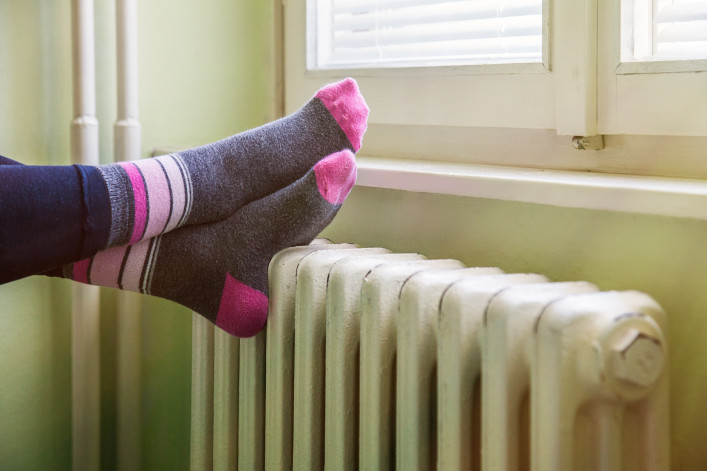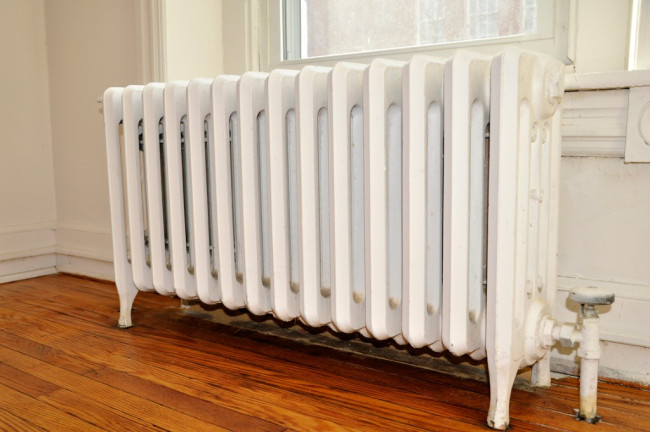It's 7 degrees outside. Inside your apartment, it's a sweat lodge.

In a basic one pipe-system, the steam supply heads to your radiator in the same pipe that carries condensed steam back from your radiator.
iStock
It's a common conundrum in steam-heated buildings: Even when you turn off your radiators, your apartment is a miserable sweatbox. Guiltily, you throw open your windows even in sub-freezing weather; on milder winter days, when your windows don't breathe enough relief into your heat island, you sometimes turn on the air conditioner.
Meanwhile, some of your neighbors are complaining that they’re not getting enough heat, so cranking down the basement boiler fueling your inferno isn’t the answer.
What now?
The problem with steam heating
“Traditional steam systems in residential buildings were installed when the cost of energy was cheap and providing enough heat was more important than individual control,” says Peter Varsalona, a professional engineer at Rand Engineering & Architecture.
In a basic one pipe-system, the steam supply heads to your radiator in the same pipe that carries condensed steam back from your radiator.
“These systems were installed where low initial cost and simple installation and operation were desired, and weren’t designed for end-user control; as a result, they’re very hard to balance within a building," says Varsalona. "But back then, it didn’t matter if you had to open a window.”
In a two-pipe set-up, whereby the steam supply and condensed steam have separate pipes, greater system-wide control options are now available, but many systems were installed without them, and the cost to retrofit can run into the tens of thousands of dollars.
What you can do about it
First, what not to do: A lot of people mistakenly believe that the circular knob on a radiator can actually be used to regulate temperature, when it’s actually just an on-off switch, says Varsalona.
“If you try to use it to regulate the steam supply into the radiator, particularly in a one-pipe steam system, pipe 'banging' noises can occur since steam and condensate are trying to flow in opposing directions through a smaller opening,” says Varsalona.
A better solution, if you can afford it, is to install a device on each radiator that gives you some control.
Exactly what type of device you will need depends on whether you have a one- or two-pipe radiator system. (Look under your radiator to see how many pipes are coming out of the floor.)
In a one-pipe system, a thermostatic radiator valve (TRV) controls the amount of air inside your radiator. The more air you let in, the less space is available for steam, causing your radiator to generate less heat.
But the valve is not exactly a thermostat that can be set to a specific room temperature.
"It has five or six settings that allow you to regulate temperature pretty effectively,” says Varsalona. A good super can install it, he says, or an outside plumber can do it for about $250 per radiator.
On the downside, he says, “because steam is constantly entering and exiting the radiator, the valves tend to require a lot of maintenance and they can fail after a year or two.”
Two-pipe steam systems require a more sophisticated "solenoid" device that regulates the flow of steam into the radiator.
“They’re more expensive, maybe around $750 to $1,000 including installation, and you have to run power to it since the device has an actuator,” says Varsalona.
Why your neighbor is freezing
As to why traditional steam-heated buildings tend to heat up unevenly, Varsalona says it’s a combination of things.
“Usually there’s a riser with a branch on every floor that feeds the radiators, so you have to operate the boiler long enough to reach the radiators furthest away,” he says. “The result is that lower floors tend to be overheated and upper floors are underheated.”
The heating system may have even been purposely unbalanced when installed—originally designed to deliver less heat, for example, to a sun-exposed swathe of the building since blocked by surrounding high-rises.
Balance problems have led newer-constructed buildings to shift to individually controlled PTAC and heat-pump systems, as well as central ‘hydronic’ systems that circulate hot water to radiators instead of steam.
“When a hydronic system isn’t balanced, it usually has to do with building construction issues such as missing flow balancing and zone valves, undersized pumps, or poor air venting that are preventing an adequate hot water supply to parts or sections of the building,” says Varsalona.
You Might Also Like


























